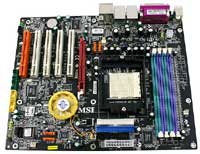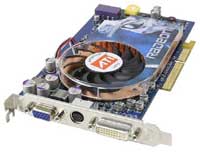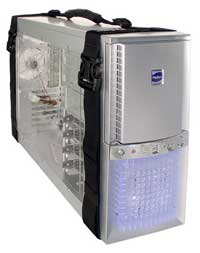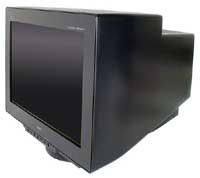High-End Gaming System
We've covered the Mid-Range and Budget sectors, so all that is left is the High-End. While there is a lot of competition in the other sectors, there really are not that many options on the bleeding edge. If money is no object - and it shouldn't be if you're thinking of spending a couple of months' rent on a game system - you can go out and buy the best parts that are available. That is in essence what we have in our High-End rig. However, we really don't recommend that anyone actually spend this much money on a gaming system. A better plan would be to pick out a few of the items that you think are the most worthwhile and stick with the Mid-Range configuration for the remainder of the system.
| High-End AMD Athlon 64 System |
| Hardware |
Recommended Component |
Price |
| Processor |
AMD Athlon 64 FX-55 1MB 2.6 GHz (939) |
877 |
| Motherboard |
MSI K8N Neo2 Platinum |
131 |
| Memory |
2x512MB Crucial Ballistix 2-2-2 1T |
262 |
| Video Card |
Sapphire X800 XT 256 MB GDDR3 AGP |
461 |
| Hard Drive |
Western Digital Raptor 74GB SATA 10000RPM 8MB Model WD740GD |
173 |
| Hard Drive |
Maxtor 300GB SATA 7200RPM 16MB Model 6B300S0 |
207 |
| Optical Drive |
NEC DVD+/-RW Drive Model 3500A |
72 |
| 2nd Optical Drive |
Lite-On 16X DVD-ROM Model SOHD-167T |
30 |
| Sound Card |
Creative Labs Audigy 2 ZS |
75 |
| Case |
Antec Lanboy Aluminum |
88 |
| Power Supply |
Antec True480 480W PSU with Blue LED |
95 |
| Display |
NEC/Mitsubishi FP2141SB-BK 22 |
634 |
| Speakers |
Logitech Z-680 5.1 THX Certified |
236 |
| Keyboard |
Logitech Internet Keyboard |
17 |
| Mouse |
Microsoft IntelliMouse Optical |
24 |
| Bottom Line |
|
3382 |

Click to enlarge. |
The choice of parts in some areas is not all that different from the Mid-Range configuration. Our motherboard recommendation remains with the MSI K8N Neo2 Platinum; even more so than the Mid-Range sector
If you are actually thinking about spending this much money on a computer, waiting for PCI Express motherboards with SLI support would really make sense. In that case, you could go with a 6800GT card now and upgrade your gaming performance with a second 6800GT when you need more performance. We expect the SLI-capable motherboards to begin appearing at retail within the next month. Until we actually see the parts on sale, we will not be listing them as an actual recommendation.
We also continue to go with the same NEC DVD burner as well as the keyboard and mouse. Some people really prefer wireless input devices, but for gaming, we personally continue to prefer wired variants. As before, go with what you're most comfortable using. The other components are all upgraded, but we are reaching the point of diminishing returns. The total system cost is roughly twice that of the Mid-Range system, and yet performance is, at best, maybe 25% faster. Let's look at the specifics.
We start with what is the fastest current processor, the AMD Athlon FX-55. Running at 2.6 GHz and with strained silicon, our initial results have shown it to be faster than any other CPU in games, and those looking for even more performance can try their hand at overclocking it. For the RAM, we have upgraded to some high quality, low latency Crucial Ballistix. With 2-2-2 timings at 200 MHz and low timings all the way up to its maximum clock speed of around 270 MHz, the Crucial RAM performs very well. Any memory that uses the latest Samsung TCCD chips is also worth consideration, and it can usually reach even higher clock speeds. OCZ PC3200 Platinum Rev. 2 is one such example, and we use the Samsung TCCD DIMMs as our standard RAM for testing. If you don't plan on overclocking, however, there's really little to differentiate one set of 2-2-2 timing RAM from another.

Click to enlarge. |
For the graphics card, we have selected ATI's X800 XT chip. The X800 XT Platinum Edition and 6800 Ultra are also possibilities for those who simply must have the best. The X800 XT strikes a nice balance between price and performance, as it outperforms the 6800GT in most games that don't have Doom 3 in the title and it costs $75 less than the slightly faster chips. Sapphire wins this category as the least expensive X800 XT card. For hardcore Doom 3 players, the NVIDIA cards remain the better choice, and if you're interested in SLI, there are two important things to remember. First, of course, is that you need to wait for PCI Express motherboards to become available, which may be a month or two out - we're sure that NVIDIA's partners are trying desperately to get the boards to market before Christmas. The other critical factor is that you will need to "downgrade" to a 6800GT. As the 6800 Ultra is a two-slot design, there will not be room to put two 6800 Ultras in a system - at least, not on the boards that we've seen. Two 6800GT cards are significantly faster than a single 6800 Ultra, though, so the tradeoff is worth it in our book.
Our hard drive selection may be overkill, but we have paired the fastest SATA hard drive available - the Western Digital Raptor - with a fast, but spacious, Maxtor DiamondMax 10 (a.k.a. Maxline-III) drive. The Maxtor drives are so new that we really don't have much data in terms of reliability, so if you have any personal experience with the drives, we'd like to hear from you. On the optical side of things, we have added a standard DVD-ROM drive to the burner, allowing for DVD to DVD copying - or CD to CD copying - if you need it. The speakers are Logitech's Z-680 5.1, which provide great sound at a reasonably affordable price. They compare favorably with Klipsch ProMedia Ultra 5.1 speakers and cost significantly less. We have also thrown in a sound card for good measure - the Creative Audigy 2 ZS is designed with gaming in mind and provides better quality than most integrated solutions as well as slightly better performance.

Click to enlarge. |
Finally, we wrap things up with the case and monitor selections. For the case, we have selected the Antec Super Lanboy paired with an Antec True480 power supply. It is very similar to the SLK3700-BQE in design, but uses an aluminum body instead of steel and has a case window on the side. Two 120 mm fans are included, and it also comes with a carrying harness that can come in handy if you're the type to haul your computer to LAN parties. Lian Li and Silverstone also make some very nice cases if you're willing to spend more money. The majority of high-end cases lack a power supply, so we used an Antec True480 480W PSU. The Antec NeoPower 480 and Ultra X Connect are also alternatives worth considering - they are 480W and 500W respectively, and they have detachable power rails so that you can avoid cluttering up the insides of your case with unused cables.

Click to enlarge. |
Our choice of display is a large 22" (20.0" viewable) NEC monitor. Providing high refresh rates (85 Hz) at even 2048x1536 as well as the ability to run at other resolutions without interpolation - the Achilles heel of LCDs - we still prefer a large CRT to LCDs for games. It also comes with four USB ports, if that sort of thing interests you. There are other 22" NEC CRTs that cost less, but if you want a huge monitor for gaming, you'll want one that supports 2048x1536, as few games support the less common resolutions such as 1920x1440. The drawback for such a CRT is that it is large and heavy, making it less than ideal for transportation to LAN parties.

Click to enlarge. |
If portability is your style, we recommend a good quality 19" LCD instead. Unlike CRTs, an LCD's viewable area is the same as their screen size, so a 19" LCD is really only slightly smaller than a 21/22" CRT (which both have a 20.0" viewable area). Low response times are the most important aspect of LCDs that will be used in gaming, and for this, we recommend the ViewSonic VP912B 19" LCD. With a 12 ms response time, there is virtually no ghosting. It does cost more, but it works great. The native resolution is 1280x1024, but we have not yet encountered any 19" LCDs that support 1600x1200 with a 12 ms response time. Besides, 1280x1024 is not quite as demanding of the GPU as 1600x1200 - if your LCD runs at a native 1600x1200 resolution, you'll need to either lower the resolution when game complexity increases or else, you'll need to upgrade your GPU more often. Neither one is very appealing. Remember also that you want a DVI-D connection on any LCD; otherwise, you're still stuck with an analog signal that can affect image quality, particularly at high resolutions.















70 Comments
View All Comments
blckgrffn - Tuesday, November 23, 2004 - link
At Newegg, sorry.blckgrffn - Tuesday, November 23, 2004 - link
$35 shipped, 420W thermaltake silent purepower w/18A on the +12 rail - can't beat that. No sense in not upgrading to it in my opinion. Also has two SATA power connectors. It may not be the best, but it is a good brand for low dough, and it regularly retails for under $40. I see no reason not to reccommend it as an alternative, at least.Just my $.02 :-)
JarredWalton - Tuesday, November 23, 2004 - link
I was gone for the weekend due to a personal matter, which is why I have not commented much yet. Basically, the budget segment is extremely difficult to target without cutting some corners. The PSU is definitely one of the corners that was cut. I will certainly agree that a cheap PSU is not the best option, but for a moderate system it should do okay. We do not build and test every one of the systems we recommend here, although we do test the majority of the parts. For the budget system, even a moderate PSU is going to add $50 to the price. It might be worth it, but I would go with the generic for a little while if you're on a tight budget.The mid-range use of the SLK3700-BQE case and PSU is a different story. The 350W Antec PSUs are actually quite good and when paired with that setup I have yet to experience any issues. If you're going to add in a second hard drive and optical drive and try overclocking, it could present a problem, but for the stock recommendation it will work.
I thought I made the PSU situation clear in the article, but looking back I guess it was sort of relegated to a few comments made in the high-end and component summary pages. A good PSU is never a bad investment. Trying to convince someone to spend $75 on a name-brand 400W+ PSU instead of upgrading some other component is difficult to do, unfortunately. I'll make sure I don't overlook this in the future - particularly on the mid-range systems.
Gorion: The component summaries were arranged in order of price, with my suggestion of what budget each component falls into. You'll note that many of the parts do not match up directly with the system we put them in, for example we had to use a "mid-range" priced motherboard for the Intel budget setup. The graphics cards in particular are where we "overspent" - which makes sense for gaming.
You're right on the mouse: the MX510 is the wired version. My bad. Basically, get what mouse you like. I have tried the MX510 before, and while not bad, it's a personal taste. I like the 4th and 5th buttons on opposite sides like the "cheap" MS mice. For precision, Logitech may be better, but I am definitely not hardcore enough to be able to tell the difference between mouse precision on these models. :)
Glassmaster - Tuesday, November 23, 2004 - link
#45: I'm not suggesting that a PSU recommendation should account for overclocking, however, on AMD's offical forums, where I help with Athlon 64 troubleshooting, insufficant PSUs are the most common problem. People are having problems with their PSUs handling stock specifications when they do something demanding, like play a modern game. This is a gaming guide after all...That's why I ask if you build and stress test these systems with the latest games before making a recommendation. If you do, and you find that a particular cheap generic PSU (with less than the consensus recommendation of 18-20A on the 12V rail) works well, that would be good to know. However that has not been my experience.
I wouldn't bother to post at all if I didn't respect this site a lot and enjoy reading it--I would just stop visiting.
Glassmaster.
Wesley Fink - Tuesday, November 23, 2004 - link
RE: The Epox budget board. Jarred had originally selected the Epox budget nf3-250Gb for his budget AMD gamer, but I shared many of the emails I had received re: memory problems with that board. Nothing major, but memory compatibility issues and 4-dimm 333 downclocks not seen with the Chaintech board. While we all agree the Epox has a bit better feature set the Chaintech is known to be rock solid and friendly to just about any memory you feed it. That is the reason for the Chaintech choice for Budget. If you know your memory choice works well with the Epox then by all means choose that board.As an overclocker I have learned the hard way how very important the PS is for Athlon 64 and Socket T Intel. However, most gamers are NOT overclockers - they may overclock the video card but they rarely do much with system overclocking. Given that, Jarred's PS choices make more sense, though I do agree budget Power Supplies are the weakest links in most systems. I'm sure those gamers that "system-overclock" will throw some rocks here, and there are exceptions to every generalization.
thegreatbernie - Tuesday, November 23, 2004 - link
I haven't been able to find the Albatron GeFORCE 6800 GT 256MB GDDR3 for $374. Newegg has it for $455.Gioron - Tuesday, November 23, 2004 - link
Jarred:Two nit-picks, the first being the motherboard chart on the component summary page. The third motherboard down threw me for a second, until I realized it was the third budget motherboard, not the mid-range motherboard it was listed as.
Second, the MX510 is a wired mouse, not wireless. The wireless Ligitech mice are the MX700 and MX1000, the MX510, MX500, and MX300 are all wired mice. I'm guessing you're thinking about the MX700 mouse, which I admit is a bit of an acquired taste, but if you haven't used one before, I'd highly recommend trying out the MX510 before dismissing it.
Disclaimer: I personally use an MX1000 as a replacement to my MX700, but I freely admit its not for everyone.
SDA - Tuesday, November 23, 2004 - link
Damn, I hate to double-post, but I just found something interesting while poking around:http://forums.anandtech.com/messageview.aspx?catid...
Might be worth a read for those of you that don't understand what I have against low-quality power supplies.
SDA - Tuesday, November 23, 2004 - link
#38, no, I guess it doesn't :( No offense to AT, but I doubt they bother-- after all, the PSU is such a trivial piece of hardware, isn't it? Sigh.. anyway, correct me if I'm wrong, but it'd seem that the PSU in the Athenatech case is an L&C unit. Deer/L&C units aren't exactly.. known for their quality.Now, I don't want to seem like I'm sniping, because overall I think this is a pretty good guide. Everyone's going to have their own suggestions and their own favorite parts. A quality PSU isn't something that one would pick just because of their preference, though, it's something one would pick because of their sanity. I've lost count of the number of malfunctioning systems I've seen fixed with replacement PSUs, not to mention how many cheapo power supplies I've seen fail in amusing ways before their time.. picking a cheap PSU to power a solid system is a newbie mistake, it's a shame to see a pro make it.
bofkentucky - Tuesday, November 23, 2004 - link
#39Except it is overpriced, uses an overpriced processor, uses slow ram and is feature limited (No on board SATA). Dothan has potential, but wait until the 915 based dothan boards hit the streets, then you will see a real performance option.